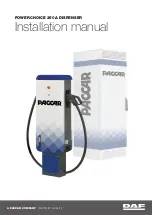
6
4.
MAINTENANCE
The maintenance schedule depends on use and operating conditions but, generally, it should not exceed three months.
The maintenance operations have to be made by specialised personnel, in compliance with safety rules. At our offices, you
can find the “Routine and extraordinary maintenance forms”.
Please, follow the instructions in paragraph 4.1 “Put the equipment out of service”
4.1
Put the equipment out of services
When you want to do a routine or extraordinary maintenance on your Battery Charger, or you do not want to use it for a
long time or there is a fault, you must keep it out of service.
Please follow these instructions:
1.
Switch off the Battery Charger
2.
Rotate the AC mains switch in “off” position and disconnect the plug.
3.
Disconnect the battery plug.
Should you wish not to use your Battery Charger for a long spam of time, please do not expose it to heat or atmospheric
agents, but keep it in a dry, safe place. The AC main plug and the battery plug must be raised from the ground and
secured.
4.2
Routine Maintenance
1.
Clean carefully the AC and battery cables. Check they are not damaged or burnt. In this case, replace them
immediately.
2.
Check the AC mains and battery plugs. If they are crushed or burnt or damaged, replace them immediately.
3.
Electrical equipment must not be exposed to dust and humidity. Clean the Battery Charger. Should it be too dirty or
damp, put it in a safer place.
4.3 Troubleshooting
L1
L2
L3
L4
Display
CAUSE
off
Ac Mains (Vac) is missing: check the connection of AC Mains plug, the
main switch of the electric line, the input AC fuses.
E. 0
No Alarms
E. 1
Battery voltage is missing at start (voltage lower than the 40% of
nominal voltage). The battery is not connected to the charger, the
battery plug is damaged, a battery cable is interrupted or the output
fuse inside the charger has burnt.
●
E. 2
Battery voltage is below the min. threshold (63% Vnom)
●
E. 3
Battery voltage is below the second threshold (65% Vnom) after 1
minute
●
E. 4/5/6
Intervention of a thermal probe on semiconductors (NTC1, NTC2,
NTC3)
●
●
E. 7
Maximum charging time exceeded
(time out error)
Battery not fitted for the charger, sulphated, damaged then not able to
reach 2,4V/el within 9h.
Wrong card setting
●
●
E. 8
Error of curve – It has been selected a curve not implemented in the
charger.
●
E. 9
Error of software (Watchdog). Internal card error.
●
E. 10
Error of current – The current has been below 1A for 30 consecutives
seconds during phase I or II. Possible also during III phase if
preservation is expected in the charging profile
●
●
●
E. 11
Error power-fail – Only for HFT models
●
E. 14
Error manostat AIR – When pump is working the charger reads the
status of the manostat. In case of low pressure the charger stops the
charge and the pump. After 30s the charger try to restart both
charging and the pump. If problem persist and pressure remains low
the charger will keep on signalling this error.
5. WARRANTY
Duration
Atib Elettronica guarantees these products for one year. Extended guarantee must
be defined in advance
Starting date
The delivery date from Atib Elettronica is considered the starting date of the
warranty
Covering
Atib Elettronica commit ourselves to:
Defective components will be repaired or replaced free of charge
Labour free of charge nearby our factory. If carry out nearby the customer will
be against payment
The delivery costs of the components are at the consignee’s expense
Loss of right
Warranty is not valid if
The instruction of this manual is not observed
it is proved an improper use or a violation or modification of the charger
Charger is used out of range specified for that model or written in the order
UK











































